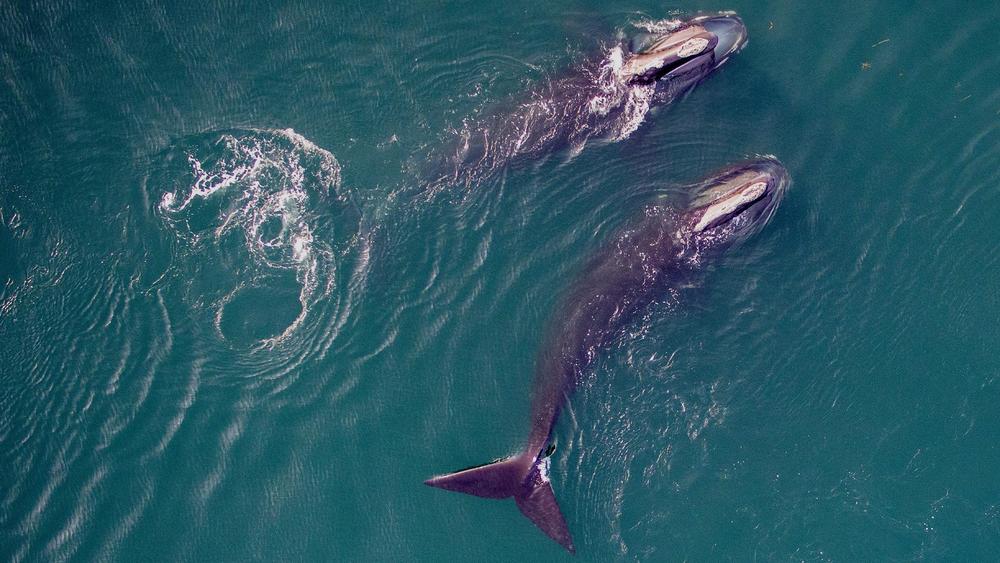
Section Branding
Header Content
Endangered right whale deaths 'devastating for the species'
Primary Content
LISTEN: GPB's Peter Biello speaks with marine scientist Julia Singer about recent North Atlantic right whale deaths.

Two endangered North Atlantic right whales turned up dead off the east coast in the past two months, one of them off Tybee Island. Scientists have been worried about the species. There are about 360 remaining, and boats, fishing gear and other hazards persist off the east coast. For more on this, we turn to Julia Singer. She’s a marine scientist with Oceana, a non-profit dedicated to protecting and restoring the world’s oceans. She spoke with GPB’s Peter Biello.
Peter Biello: So earlier this month, a dead North Atlantic right whale was found off the coast of Tybee Island. Last month, one turned up off Martha's Vineyard in Massachusetts. Is there anything to make out of two sightings of dead right whales in such a short period?
Julia Singer: It is extremely tragic to hear about both of these dead whales, as well as other whales that have been entangled and struck by boats. But unfortunately, this is nothing new for the North Atlantic right whale. They have been victim to boat strikes and entanglements at very high rates for many years, but particularly since 2017, and we need to make changes soon if we don't want to keep hearing these stories about these dead whales.
Peter Biello: What happened in 2017 that made the rate of entanglements or ship collisions tick up?
Julia Singer: There's actually been an increase in recent years due to the North Atlantic right whales shifting their distribution, partially due to climate change. They're following their food sources, which are these tiny organisms called copepods, and they're following them into harm's way. And in 2017, nothing big changed there, but that was the year that NOAA decided to start tracking this more closely. And they enacted what is called an "Unusual Mortality Event," which is just when they start to pay a little bit closer attention to the whale deaths and serious injuries.
Peter Biello: And during this Unusual Mortality Event, I believe the number was 38 deaths. Is that correct?
Julia Singer: Yes. There have been 38 deaths since 2017. But in addition to that, there's also been 34 serious injuries, which is where we haven't actually seen that the whale has died, but we expect that they will die from those injuries. And then 51 additional injuries or illnesses that are caused mostly by human activities but aren't necessarily resulting directly in deaths.
Peter Biello: That was my next question. How much of this is caused by human behavior?
Julia Singer: At this point, we don't see any North Atlantic right whales dying naturally of just old age. We occasionally see some young calves that are dying that may not be directly caused by human interactions, but as far as when we see a whale and can identify what killed it, we have found that it's either vessel strikes or entanglements almost every single time.
Peter Biello: It seems as though there's a conflict here, then, between human activities in the ocean and the ability of this species to thrive. The Washington Post put the question bluntly: "Should you eat lobster?" Is that a fair question, given what we know about what's happening to these whales?
Julia Singer: That is a fair question. But I think instead of putting all of the onus and all of the responsibility on the consumer, we should be putting more of our questions towards the government, because there's things that the government can do on both the vessel strikes and on the entanglement side to make it so it's not up to the consumers to protect these whales, but that they're protected by our own government.
Peter Biello: What could the government do? What kind of regulations could it put in place to make the ocean more hospitable to these whales?
Julia Singer: So one of the main things that we're hoping to see soon is an update on what is called the vessel speed rule. In 2008, NOAA put out a rule that requires certain vessels 65 feet and up to slow down when whales are expected to be present, or when these whales have been seen. And since 2008, the whales have shifted their distribution. And there's been just a lot more traffic in the oceans. And so the rule needs to be updated. And in 2022, NOAA did release an update to the proposed rule that would drastically help to protect these whales from boat strikes by doing things like expanding some of these slow zones and including vessels 35 to 65 feet in those zones. But the rule has not been put into place yet. So by Secretary Raimondo and President Biden pushing this rule and finalizing it in a timely fashion, we could prevent more of these vessel strikes from happening.
Peter Biello: Two whale calves were spotted off the coast of several Southern states last week, including Georgia. These were new to scientists. What do you make of this news?
Julia Singer: So we are always very excited to see new North Atlantic right whale calves. This brings our number for the year up to 19 calves. And NOAA says that a relatively good year is around 20 calves. So we are right at that number. But we're still a long way away from the real target, which is around 50 calves, which is what's needed in a year to actually allow the species to recover properly. I think one thing that's really important to note is that while it might not seem like that many whales are being killed, just because we've heard about a few in the news, one thing to note is that there are only 356 of these whales left in the entire population. And so scientists estimate that losing just one whale a year is enough to put the species back and stop their recovery. So every single time we hear about one of these whales being hit, it is devastating for the species.

